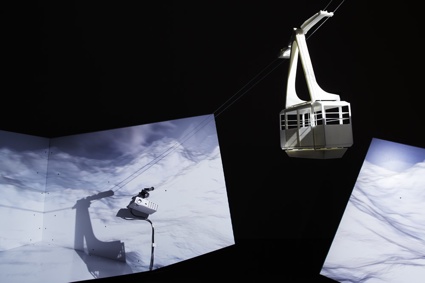 Pierre-Yves Boisramé, Untitled, 2012. Photo LABoral/Marcos Morilla
Pierre-Yves Boisramé, Untitled, 2012. Photo LABoral/Marcos Morilla
Elastic Reality is an exhibition about the internet, about its ubiquity and ability to permeate physical space, it’s about the way permanent connectedness has added layers and complexity to the notion of ‘reality’. Elastic Reality is not just reality, nor is it simply virtual reality or augmented reality, it is an expanding, ever-morphing reality.
This ever more complex environment blends the virtual and the real, the dataflow with the landscape. Whereas new terms are regularly coined to describe this state of things, none truly encapsulate the multi layered realm we inhabit. Hence, comes the notion of elastic reality, which was inspired by the works on display in this exhibition. The participating artists not only play with these distortions of the “real”, but also pioneer new ways to interact with their work. The formal exploration of new interfaces is as much part of their preoccupation, as is the content of their work, and the kind of commentary on the current state of reality we live in.
Elastic Reality was co-produced with Le Fresnoy, Studio des Arts Contemporains, a post-graduate art school and audio-visual research and production centre, where young artists are invited to produce new work under the mentorship of guest artist-professors. The exhibition is a selection of the works produced in the course of last academic year (ending in June 2012.)
Some of the works are openly political, others are of the ‘move around and interact’ kind, some invite to introspection, others are made to dazzle. There were good surprises (notably Tarnac, Chaos and Grace.) and a few fresh ideas but I must say that half of the description texts drove me CRA-ZY. Do french-speaking people really have to write in such a convoluted way? Does being arcane equal being smart?
Anyway, here’s a couple of works i found particularly interesting:
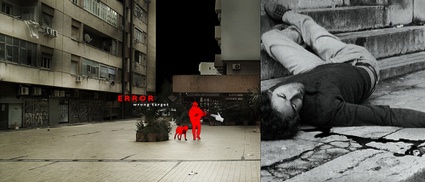 Vincent Ciciliato, Tempo Scaduto, 2012
Vincent Ciciliato, Tempo Scaduto, 2012
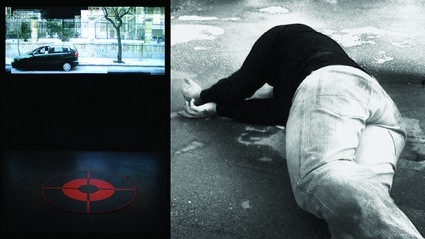 Vincent Ciciliato, Tempo Scaduto, 2012
Vincent Ciciliato, Tempo Scaduto, 2012
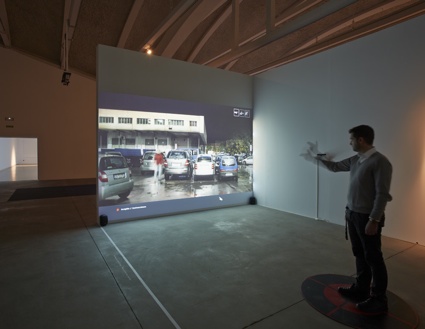 Vincent Ciciliato, Tempo Scaduto, 2012. Photo LABoral/Marcos Morilla
Vincent Ciciliato, Tempo Scaduto, 2012. Photo LABoral/Marcos Morilla
The Tempo Scaduto game is set in the Palermo of the 1980s, when magistrates Giovanni Falcone and Paolo Borsellino began a campaign of arrests, trials and convictions of members of the Cosa Nostra.
The Mafia’s retaliation was brutal. Bombings, murders, attacks on touristic spots and other demonstrations of violence. Vincent Ciciliato grew up against that background and the game he has developed unfolds in six different locations in Palermo, some of which are the stage of a murder. Players have to re-enact the murders and fire at moving targets inspired by real murders but they don’t actually know if the person is an innocent passerby or the specific person who has to be eliminated. The identity of the victim is revealed only after they have been shot (to kill people, players have to do the well-known gesture of holding a handgun up and then aiming and firing with the finger.) The executor becomes the witness when the shot is followed by a series of archives documents that reveal the murder that took place at that exact spot some 30 years ago.
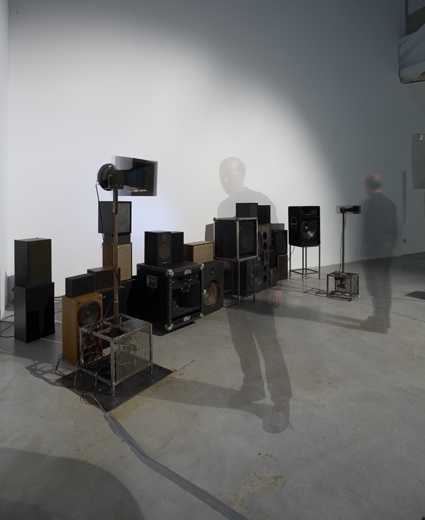 Zahra Poonawala, Tutti, 2012. Photo LABoral/Marcos Morilla
Zahra Poonawala, Tutti, 2012. Photo LABoral/Marcos Morilla
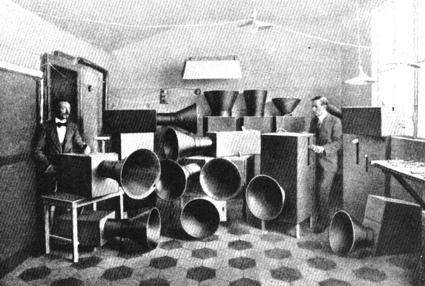 Luigi Russolo (left) and his assistant Ugo Piatti with the Intonarumori
Luigi Russolo (left) and his assistant Ugo Piatti with the Intonarumori
Zahra Poonawala‘s Tutti installation made me think of Futurist composer Luigi Russolo‘s magnificent Intonarumori but the reference was actually the acousmonium or loudspeaker orchestra, a set of 80 loudspeakers of various sizes and shapes designed by Francois Bayle for tape playback.
Tutti invites visitors to a dynamic experience of listening by walking around the components of the orchestra. The characters each have their own volume, register and a different personality. In front of this background the soloists stand out, isolated loudspeakers that are mobile because they react to the movement of the spectator who is incited to move to make them react. The different layers of sound intensify this spatial organisation. From a fundamentally complex chord which forms a base, the reaction to the spectators’ movements determines the changes of intensity, ignites solos which stand out from the sound mass.
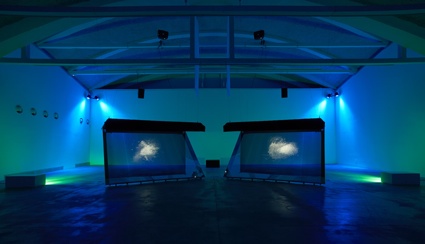 Ryoichi Kurokawa, Mol, 2012. Photo LABoral/Marcos Morilla
Ryoichi Kurokawa, Mol, 2012. Photo LABoral/Marcos Morilla
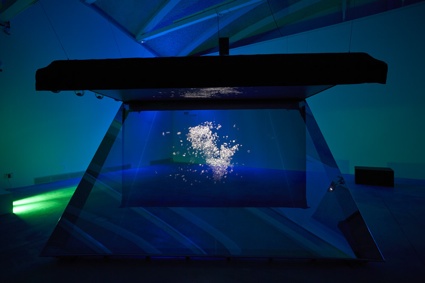 Ryoichi Kurokawa, Mol, 2012. Photo LABoral/Marcos Morilla
Ryoichi Kurokawa, Mol, 2012. Photo LABoral/Marcos Morilla
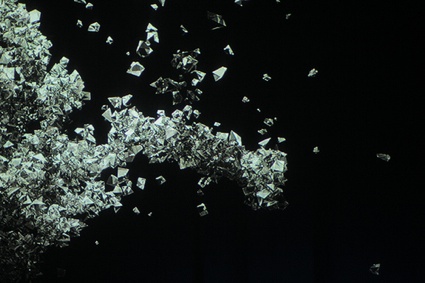 Ryoichi Kurokawa, Mol, 2012. Photo LABoral/Marcos Morilla
Ryoichi Kurokawa, Mol, 2012. Photo LABoral/Marcos Morilla
Ryoichi Kurokawa was one of the mentors of the students at Le Fresnoy in 2012 and as such, he was invited to develop his own work during his stay in Northern France. As can be expected from the über-talented artist, the result is jaw-dropping.
Mol is a two-screen audiovisual installation where gigantic holographic projections adopt highly synthetic forms that shape, explode, and move in an organic way.
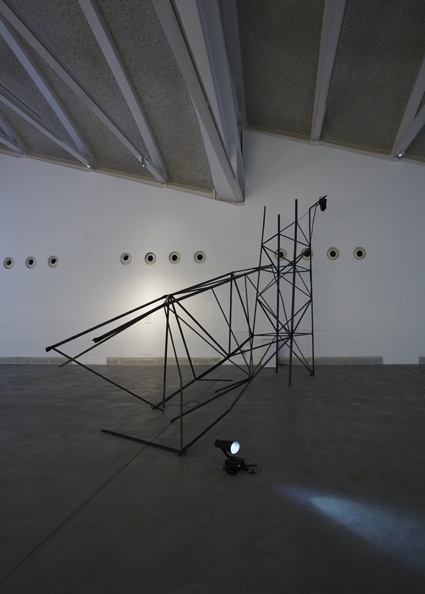 Theodora Barat, Dead End, 2012. Photo LABoral/Marcos Morilla
Theodora Barat, Dead End, 2012. Photo LABoral/Marcos Morilla
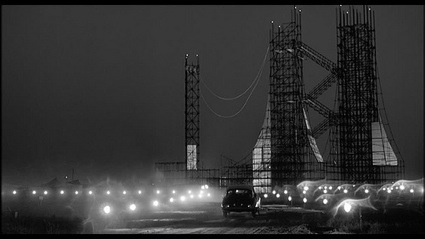 Théodora Barat, Dead End, 2012. Photo: Olivier Anselot
Théodora Barat, Dead End, 2012. Photo: Olivier Anselot
Dead End is a charismatic metallic sculpture inspired by abandoned industrial monuments and futurist constructions, the start of fantastic progress of the edification of a modernist mirage; hybrid architecture striving to rise up but also to deconstruct, to gradually deteriorate.
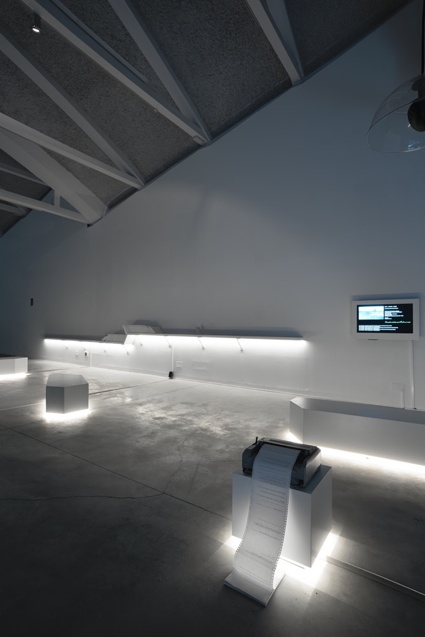 Véronique Béland, This is Major Tom to Ground Control, 2012. Photo LABoral/Marcos Morilla
Véronique Béland, This is Major Tom to Ground Control, 2012. Photo LABoral/Marcos Morilla
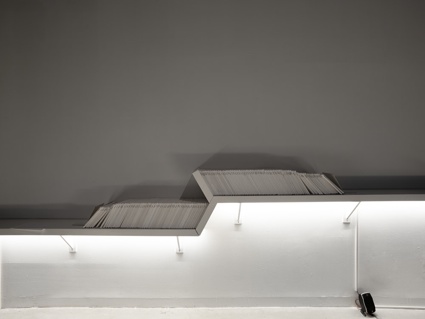 Véronique Béland, This is Major Tom to Ground Control, 2012. Photo LABoral/Marcos Morilla
Véronique Béland, This is Major Tom to Ground Control, 2012. Photo LABoral/Marcos Morilla
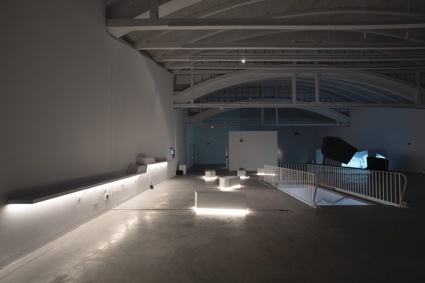 Véronique Béland, This is Major Tom to Ground Control, 2012. Photo LABoral/Marcos Morilla
Véronique Béland, This is Major Tom to Ground Control, 2012. Photo LABoral/Marcos Morilla
“The void of distance is nowhere else.”
(First sentence produced by the random text generator, March 2012)
Véronique Béland‘s installation attempts to listen to radio waves that civilizations living on other planets might broadcast. This is exactly what the SETI program has been doing with very little success since the beginning of the 1960s as part of its mission to find intelligent extraterrestrial life.
The young artist, however, proposes to capture «non intelligent» radio broadcasts and process it through an automatic generator of random texts. The data is captured by radio-telescopes from the Paris Observatory, the algorithm turns it into a text and a synthesized voice articulates it in the exhibition space in real time.
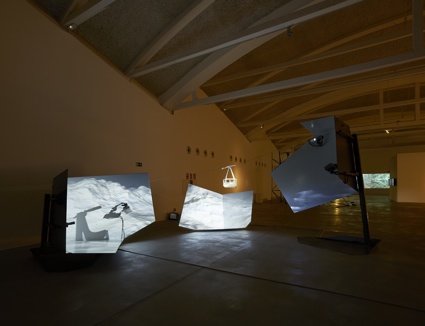 Pierre-Yves Boisramé, Untitled, 2012. Photo LABoral/Marcos Morilla
Pierre-Yves Boisramé, Untitled, 2012. Photo LABoral/Marcos Morilla
More descriptions, details and essays in the press kit.
Previously: Tarnac, Chaos and Grace.
Elastic Reality. Beyond the Exhibition: New Interfaces for Contemporary Art in Europe was curated by Benjamin Weil. The exhibition remains open at LABoral Centro de Arte y Creación Industrial (Art and Industrial Creation Centre) in Gijón, Spain, until 8 September 2013.
